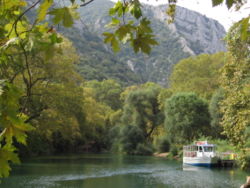Vale of Tempe
| Vale of Tempe Κοιλάδα των Τεμπών | |
|---|---|
 View of the vale with Pineios River flowing through. | |
| Floor elevation | approx. 267 metres (876 ft) |
| Length | 12.4 kilometres (7.7 mi) |
| Width | 0.7 to 1.5 kilometres (0.43 to 0.93 mi) |
| Geography | |
| Coordinates | 39°52′37″N 22°33′58″E / 39.877°N 22.566°ECoordinates: 39°52′37″N 22°33′58″E / 39.877°N 22.566°E |
| Rivers | Pineios River |
The Vale of Tempe (Greek: Κοιλάδα των Τεμπών) is a gorge in the Tempi municipality of northern Thessaly, Greece, located between Olympus to the north and Ossa to the south, and between the regions of Thessaly and Macedonia.
The valley is 10 kilometers long and as narrow as 25 meters in places, with cliffs nearly 500 meters high, and through it flows the Pineios River on its way to the Aegean Sea. In ancient times, it was celebrated by Greek poets as a favorite haunt of Apollo and the Muses. On the right bank of the Pineios sat a temple to Apollo, near which the laurels used to crown the victorious in the Pythian Games were gathered.[1]
The Tempe Pass is a strategic pass in Greece since it is the main route from Larisa through the mountains to the coast. Though it can be bypassed via the Sarantoporo Pass, the alternative route takes longer. Because of this it has been the scene of numerous battles throughout history. In 480 BC, 10,000 Athenians and Spartans gathered at Tempe to stop Xerxes's invasion. However, once there, they were warned by Alexander I of Macedon that the vale could be bypassed and that the army of Xerxes was overwhelmingly large; accordingly, the Greeks retreated.[2]
The US city of Tempe, Arizona, and the Sydney suburb of Tempe are two locations named after it, as is a farm in the Eastern Cape of South Africa, with nearby farms named Olympus and Ossa. The Vale of Tempe Road, tracing a small valley in Penang, Malaysia, and Tempe Terra on Mars are also named after it.
Local history and legend[]

In legend, the Vale of Tempe was cut through the rocks by the trident of Poseidon.[1] It was home for a time to Aristaeus, son of Apollo and Cyrene, and it was here that he chased Eurydice, wife of Orpheus, who, in her flight, was bitten by a serpent and died.
During the Third Macedonian War in 169 BC the Romans broke through Perseus of Macedon's defences here and later defeated him in the Battle of Pydna. During the revolution of Andriskos in 148 BC the valley was the site of another conflict. There were other battles fought there during the barbarian raids that mark the end of the Roman era in Greece and in Byzantine and Ottoman times.
In the thirteenth century AD a church dedicated to Aghia (Saint) Paraskevi was erected in the valley. At the southern entrance of the valley lie the remains of the Ottoman-era Hasan Baba Tekke.
See also[]
- Battle of Tempe Gorge – a description of a World War II battle that took place at the gorge
References[]
- ^ a b Chisholm, Hugh, ed. (1911). . Encyclopædia Britannica. 27 (11th ed.). Cambridge University Press. p. 578.
- ^ Herodotus VII, 173
External links[]
| Wikimedia Commons has media related to Tempe Valley. |
- Canyons and gorges of Greece
- Landforms of Larissa (regional unit)
- Natura 2000 in Greece

